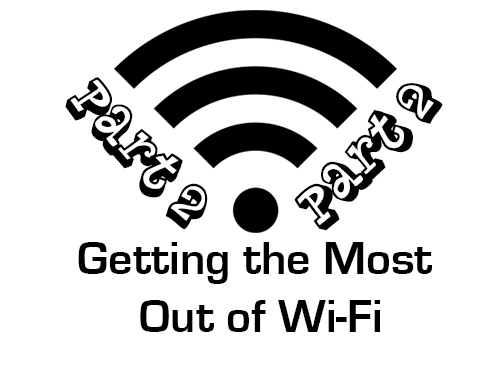
In part one of “Getting the Most Out of Wi-Fi”, we covered the basics: what you should be looking for in a router, where to place it in your home, as well as how to physically connect it. There’s a lot to absorb here, so it’s important to have a good handle on the basics. If you missed last week’s post, please click here . While wireless Internet feels like magic sometimes, it isn’t, though it would be nice to just make a strong signal appear out of thin air! Today, we’re going to expand on our foundation, and introduce ways to improve your Wi-Fi experience, from “channel changing” to adjusting antennas, to wireless access points, we’ve got you covered.
In Part 1, we discussed “dual-band” routers. For a refresher, dual-band means that the router will support frequencies at 2.4 Ghz as well as 5.0 Ghz. At the current time, most devices run at 2.4 Ghz, and there are 14 different channels with which your router can operate. In order to receive the best speed (throughput) with the least interference, channel 1, 6, or 11 is your best bet. Most routers are set to “auto” which means that the router selects the channel that it feels is best. Where we run into problems is if a neighbor has their router set on the same channel as ours. If both routers are on the same channel, Wi-Fi speed will plummet. As you could expect, this is a huge problem in condominiums or apartment buildings. So, how can you tell if a router that’s in range of your own is on the same channel? The easiest way is to type this command into a command prompt on your Windows computer: netsh wlan show networks mode=bssid. (Leave out the period). To open a command prompt in Windows Vista or 7, click the start button, and at the bottom of the panel type cmd into the field that says “Search programs and files” and press enter. Then, simply type netsh wlan show networks mode=bssid and press enter into the black window that opens up on your screen. In Windows 8, click the magnifying glass, type cmd, then press enter. At my house, my router and one neighbor’s router will appear. Look for the name of the network next to “SSID 1”, “SSID 2” and so on. What we’re concerned with is the number to the right of “Channel:”. If another router (network) is on the same channel as ours, we should change ours.
The previous paragraph was getting a little long for my taste, so here’s a new one. To change channels on the router, open any software that was installed to manage the router, OR type the router’s address into your favorite web browser and enter the username and password for your router. If you created one, use that. If not, there’s likely a sticker on the side of your modem/router. To find your router’s address, open a command prompt using the instructions we listed earlier. In the command prompt window, type ipconfig (without a period). Scroll up in the window, and look for “Default Gateway”. The default gateway is your router’s address, so just type those numbers into the address bar on your web browser. You might have to dig around a bit, but what you’re looking for is the radio channel selection for 2.4 Ghz.
We discussed placement in the home in our last post, with the aim being a centralized location away from metal and walls. An easy way to increase your coverage area is to manipulate the antenna on your router (if it has one). Simply take a wireless device, be it a phone, tablet, or laptop and walk around the house to identify where the signal gets the weakest. Adjust the antenna, and see if your changes made a difference. If you find that your signal doesn’t reach as far as you’d like it to, consider buying a wireless extender or wireless access point. If your house isn’t wired throughout, a wireless extender is a good choice due to its low price point and wireless connection capabilities. A wireless access point will be faster and more powerful, but a wire needs to be run from the router to the access point to make it worthwhile. All of the popular networking brands make versions of each.
Almost forgot: if you want to test Internet speed, both wireless and wired, visit www.speedtest.net. Simply click “Begin Test” and let the test run. The test will be completed in a minute or two. Download speed is what we’re concerned with, so check that before and after making any channel changes or router placement adjustments. Keep in mind that you need a mimimum of 5 Mbps for HD streaming video in Netflix. Wired connections will always be faster than wireless, so plug in when you can. Wi-Fi connections can be plug and play, but with a little extra effort, tweaks can be made to make life on the Internet just a little bit better. Get the most out of Wi-Fi!
